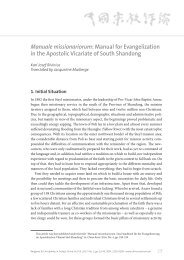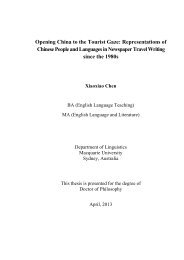EDUCATION IN CHINA
Education-in-China-a-snapshot
Education-in-China-a-snapshot
Create successful ePaper yourself
Turn your PDF publications into a flip-book with our unique Google optimized e-Paper software.
Chapter 2 – Educational reforms and current issues<br />
Box 2.1 Special policies for teachers in rural areas<br />
In recent years, the Chinese government has issued a set of<br />
policies aimed at improving the quality of rural education. The<br />
government has initiated and funded several programmes to<br />
deal with the issue of teacher shortages in underdeveloped<br />
areas, and has set up programmes to attract young people to<br />
work in rural and disadvantaged regions.<br />
Implemented with a special fund set up by the central<br />
government from 2006, the Special Teaching Post Plan for<br />
Rural Schools is an important national programme for<br />
enhancing the rural teaching force. The programme recruits<br />
graduates from universities to work for three years in rural<br />
schools in central or western China, mainly in remote<br />
regions with minority populations and educationally<br />
disadvantaged counties. These teachers are recruited by<br />
educational administrative departments at the provincial<br />
level. After three years of teaching, teachers take a<br />
qualification exam. If they pass the exam and are willing<br />
to stay, they can keep the tenure track teaching position. In<br />
2015, around 90% of the teachers who finished the threeyear<br />
teaching period stayed in their posts.<br />
Recognising that the uneven quality of teachers results in<br />
a big gap in educational quality between urban and rural<br />
areas, the government has sought to build communion<br />
among rural and urban teachers. Teachers in large and<br />
medium cities are required to work short periods in rural<br />
schools at regular intervals. Rural teachers can apply for<br />
continued learning or in-service training at county or higher<br />
level teacher training institutions.<br />
EQUAL ACCESS TO <strong>EDUCATION</strong><br />
FOR MIGRANT CHILDREN<br />
Another challenge comes from the hukou (domicile<br />
registration) system (Box 2.2). China’s economic<br />
development has caused extensive internal migration,<br />
which has raised important questions about education<br />
for both families and the government. Most children of<br />
migrants (there are around 60 million currently in China)<br />
remain in their home regions. But a large number (an<br />
estimated 36 million in 2010) accompany their parents to<br />
a new city during their schooling years (OECD, 2015). Both<br />
groups of migrant children face challenges in receiving<br />
adequate education.<br />
As mentioned earlier, neighbourhood residency is the<br />
main basis for determining school enrolment in China.<br />
This means that if migrant children want to stay with<br />
their parents, their access to education is limited because<br />
their hukou or residency status must remain the same as<br />
their place of origin. But if children separate from their<br />
parents and stay in their home regions, they suffer both<br />
mental health and educational consequences.<br />
Box 2.2 The hukou system<br />
China’s hukou system is a domicile registration system<br />
that accords rights and obligations to families based on<br />
their birth status. It determines the degree of access to<br />
social services, such as education, healthcare, insurance<br />
and social housing, that a family can enjoy in their place of<br />
residence. The modern hukou system was formalised in 1958<br />
to manage labour mobility and ensure structural stability<br />
in China. There are two types of hukou: urban hukou and<br />
rural hukou. Beginning in the 1980s, increased urbanisation<br />
began to demonstrate a sharp – and problematic – division<br />
between urban and rural hukou. In essence, the hukou<br />
system has proved to be highly discriminatory against rural<br />
hukou holders residing in urban areas. About 260 million<br />
Chinese workers are impacted by this division.<br />
Access to education is a severe obstacle faced by rural hukou<br />
holders residing in urban areas. For example, according to<br />
an estimate, only 30% of children from migrant families<br />
living in Shenzhen and Beijing attended state schools, the<br />
remaining children were either enrolled in private schools or<br />
had to return to their place of hukou registration (Koen et al,<br />
2013). Migrant students are also under-represented in elite<br />
schools. Discriminatory policies, as an outcome of the hukou<br />
system, become more problematic with each education<br />
level. For example, in Shanghai, migrant children can only<br />
attend vocational high school. Therefore, young migrants<br />
wishing to attend general high school are forced to return to<br />
their locality of registration in order to study. Furthermore,<br />
only students with local hukou are allowed to take gaokao<br />
in their area of residency. Therefore migrant students are<br />
compelled to return to their area of registration. University<br />
acceptance rates for locally registered students are, also,<br />
much higher than those with out-of-town residence. As<br />
a result, between 2009 and 2014, 97% of China’s poorest<br />
counties sent no students to Beijing’s prestigious Tsinghua<br />
University. Similarly, in Shanghai, students with a local<br />
hukou were 53 times more likely than the national average<br />
to get a place at the city’s premier Fudan University.<br />
...<br />
<strong>EDUCATION</strong> <strong>IN</strong> CH<strong>IN</strong>A: A SNAPSHOT © OECD 2016 – 29





